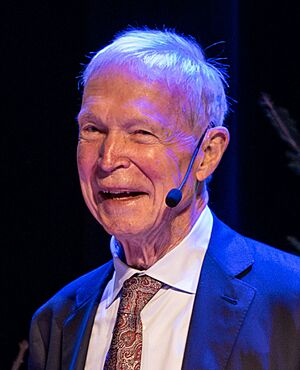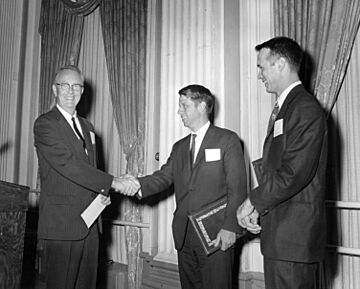John Hopfield facts for kids
Quick facts for kids
John Hopfield
|
|
|---|---|

Hopfield in 2024
|
|
| Born |
John Joseph Hopfield
July 15, 1933 Chicago, Illinois, U.S.
|
| Nationality | American |
| Education | Swarthmore College (AB) Cornell University (PhD) |
| Known for | Hopfield network Modern Hopfield network Hopfield dielectric Polariton Kinetic proofreading |
| Awards |
|
| Scientific career | |
| Fields | Physics Molecular biology Complex systems Neuroscience |
| Institutions | Bell Labs Princeton University University of California, Berkeley California Institute of Technology |
| Thesis | A quantum-mechanical theory of the contribution of excitons to the complex dielectric constant of crystals (1958) |
| Doctoral advisor | Albert Overhauser |
| Doctoral students | Steven Girvin Gerald Mahan Bertrand Halperin David J. C. MacKay José Onuchic Terry Sejnowski Erik Winfree Li Zhaoping |
John Joseph Hopfield, born on July 15, 1933, is an American physicist. He is a retired professor from Princeton University. He is famous for his work on artificial neural networks, especially the Hopfield network. This invention helped bring back interest in artificial intelligence (AI) when it was not very popular.
In 2024, he won the Nobel Prize in Physics with Geoffrey Hinton. They received the award for their important discoveries that helped create machine learning with artificial neural networks. Hopfield has also won many other awards for his work in different areas of physics, like how materials behave and how living things work.
Contents
Biography
Early Life and Education
John Joseph Hopfield was born in 1933 in Chicago. His parents, John Joseph Hopfield and Helen Hopfield, were both physicists.
He studied physics at Swarthmore College in Pennsylvania. He earned his first degree there in 1954. Later, he received his PhD in physics from Cornell University in 1958. His PhD work was about how tiny particles called excitons affect crystals.
Career Highlights
After finishing his studies, Hopfield worked at Bell Laboratories. He studied how light interacts with materials called semiconductors. He also worked on a model to understand how hemoglobin (a protein in blood) works.
He became a professor at several universities. These included the University of California, Berkeley and Princeton University. He also taught at the California Institute of Technology (Caltech). At Caltech, he taught chemistry and biology. He returned to Princeton in 1997.
In the early 1980s, Hopfield taught a special course at Caltech. It was called "The Physics of Computation." He taught it with famous scientists Richard Feynman and Carver Mead. This course helped start a new PhD program at Caltech in 1986. It was called "Computation and Neural Systems." Hopfield helped create this program.
Many of his former students became successful scientists. Some of them include Bertrand Halperin and Terry Sejnowski.
Important Discoveries and Work
Understanding Materials and Particles
In his early work in 1958, Hopfield studied how excitons interact in crystals. He created the term polariton for a special type of particle. This particle helps explain how light and matter interact in solids. His model for this is sometimes called the Hopfield dielectric.
From 1959 to 1963, Hopfield and David G. Thomas studied cadmium sulfide. They used experiments and theories to understand how light reflects off this material. Their work helped explain the optical properties of certain semiconductors.
A famous physicist, Philip W. Anderson, said that Hopfield was a "hidden collaborator." This was for Anderson's work on the Anderson impurity model. This model helped explain a physics effect called the Kondo effect. Even though Hopfield was not listed as a co-author, his help was very important.
In 1974, Hopfield also came up with a way for living cells to correct errors. This process is called kinetic proofreading. It helps explain how accurately DNA replication happens.
The Hopfield Network and AI
In 1982, Hopfield published a very important paper about neuroscience. In this paper, he introduced the Hopfield network. This is a type of artificial neural network. It can store and recall information, much like a memory. It uses simple "on" or "off" units, like tiny switches.
He later expanded his ideas in 1984. His work helped bring back a lot of interest in artificial intelligence (AI). He said his ideas came from his knowledge of "spin glasses." These are special materials with complex magnetic properties.
With David W. Tank, Hopfield also developed a way to solve difficult problems. They used a Hopfield network to find the best solutions. This method was like a process called simulated annealing. It helps find good answers by slowly adjusting the system.
Brain Activity and Modern AI
Hopfield is also a pioneer in the idea of the "critical brain hypothesis." In 1994, he connected neural networks to a concept called self-organized criticality. This idea suggests that brain activity might behave like earthquakes.
In 1995, Hopfield and Andreas V. Herz showed that bursts of neural activity, called "avalanches," follow a pattern. This pattern is similar to how earthquakes are distributed.
The first Hopfield networks had limited memory. In 2016, Hopfield and Dimitry Krotov improved them. These new, more powerful networks are now called modern Hopfield networks.
Views on Artificial Intelligence
John Hopfield has shared his thoughts on the rapid growth of AI. In March 2023, he signed an open letter. This letter asked for a pause in training very powerful AI systems. It mentioned risks like humans becoming less important. It also warned about society losing control over AI. More than 30,000 people, including many AI researchers, signed this letter.
When he won the Nobel Prize in 2024, Hopfield said he was worried about new AI abilities. He compared AI to the discovery of nuclear fission. That discovery led to both nuclear weapons and nuclear power. He said that AI is something that "has no control."
Awards and Honors

Hopfield has received many awards and honors for his important work. In 1962, he received a Sloan Research Fellowship. Like his father, he also received a Guggenheim Fellowship in 1968.
He became a member of the American Physical Society (APS) in 1969. He was also elected to the National Academy of Sciences in 1973. In 2006, he served as the President of the APS.
In 1969, Hopfield and David Gilbert Thomas won the Oliver E. Buckley Prize. They received it for their work on how light interacts with solids.
He was awarded the MacArthur Foundational Prize in 1983. In 1985, he received the Golden Plate Award. He also won the Max Delbruck Prize in Biophysics. In 1997, he received the Neural Networks Pioneer Award.
In 2001, he received the Dirac Medal. This was for his many important contributions to science. These included new ideas about how the sense of smell works. It also recognized his work on how brain cells communicate.
Hopfield received the Harold Pender Award in 2002. This was for his achievements in understanding how the brain computes. In 2005, he received the Albert Einstein World Award of Science.
In 2019, he was awarded the Benjamin Franklin Medal in Physics. In 2022, he shared the Boltzmann Medal for his work in statistical physics.
In 2024, he shared the Nobel Prize in Physics with Geoffrey E. Hinton. They won for their discoveries that helped create machine learning with artificial neural networks.
In 2025, he was awarded the Queen Elizabeth Prize for Engineering. He shared this prize with several other scientists. They were recognized for developing modern machine learning.
See also
 In Spanish: John Hopfield para niños
In Spanish: John Hopfield para niños


